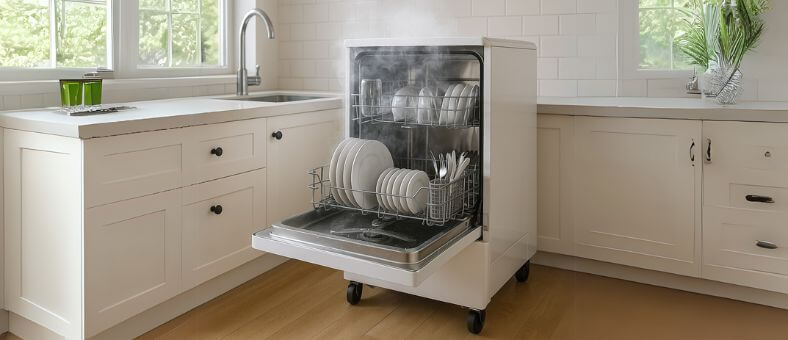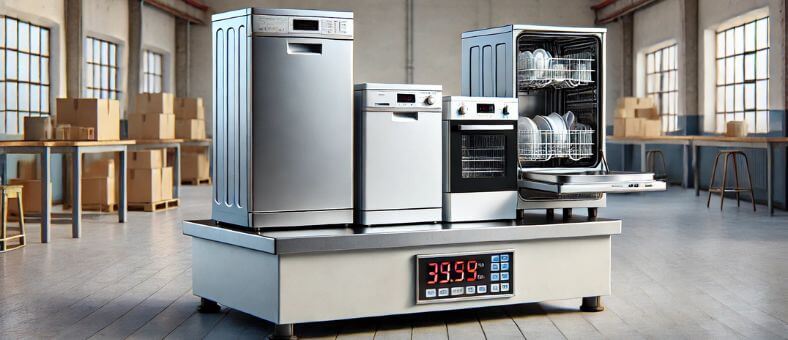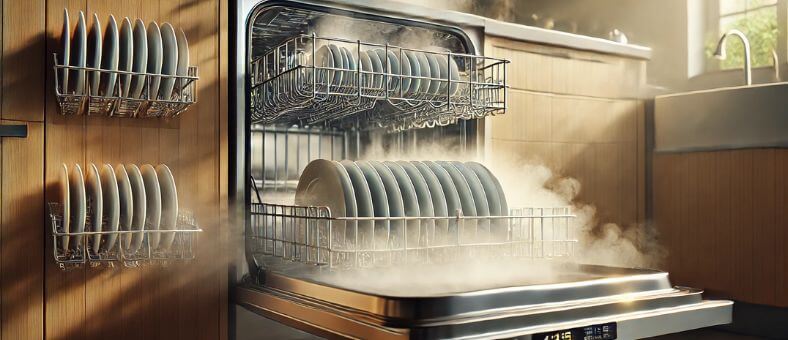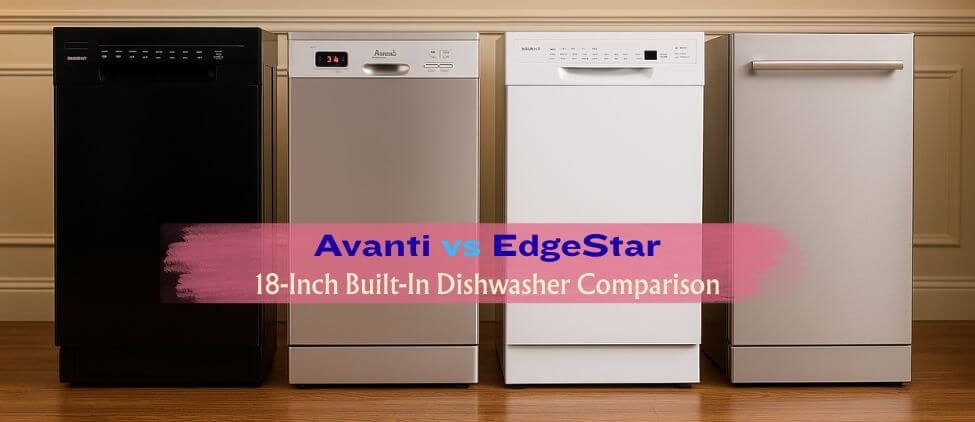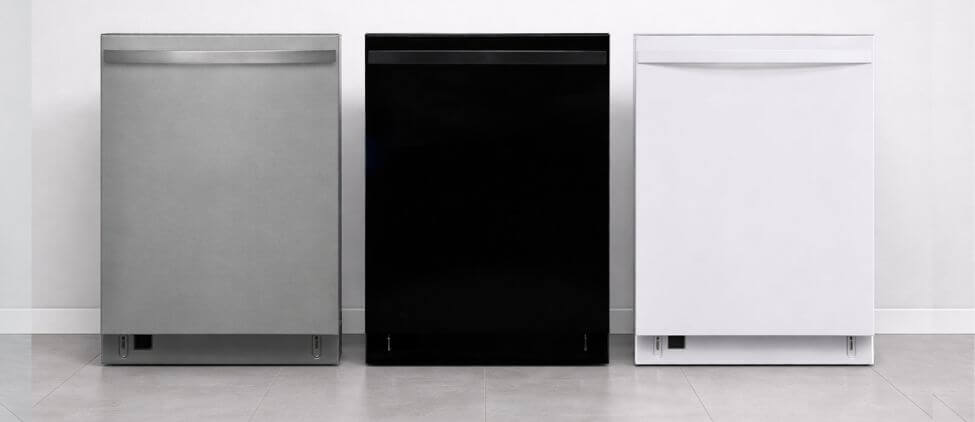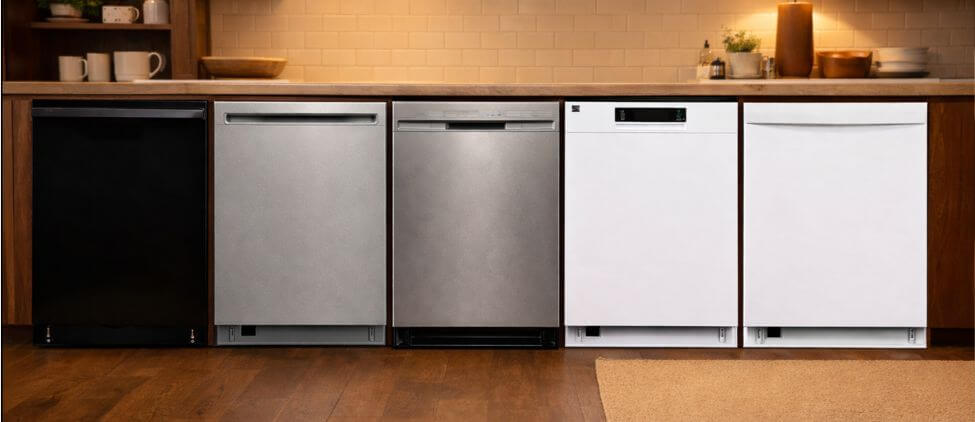Tired of scrubbing dishes in a cramped kitchen with no room for a built-in cleaning solution? The portable dishwasher might be your saving grace. But while it’s easy to appreciate the convenience it offers, have you ever pondered over “How a Portable Dishwasher Works?” If you’re unfamiliar with what a portable dishwasher is in the first place, you should check out our detailed guide on What is a Portable Dishwasher?. Behind the compact exterior of the portable dishwasher lies a world of intricate mechanics and processes.
These nifty devices have become the unsung heroes in many homes, offering the power of a full-sized dishwasher without demanding permanent space. Their design and functionality are a testament to innovation in home appliances.
Join us as we pull back the curtain on the inner workings of portable dishwashers. By the end of this exploration, you’ll be armed with knowledge that might make you the star of your next dinner conversation. So, buckle up and prepare for an enlightening journey into the heart of your portable dishwasher!
Popularity on the Rise
Recent surveys highlight a growing trend: more than 20% of urban households are now gravitating towards portable dishwashers. This shift is largely attributed to the space-saving benefits these compact machines offer, especially in tighter kitchen layouts.
Table of Contents
The Magic Behind Portable Dishwashers
Portable dishwashers, though compact, are a marvel of modern engineering. They might seem like just another kitchen appliance at a glance, but a lot is happening beneath that sleek exterior. These mobile cleaning units are a testament to how technology can transform even the most mundane tasks into something efficient and effortless.
While they might be smaller than their built-in counterparts, they focus on performance. Their design blends innovation and practicality, ensuring they always deliver top-notch results. Every aspect of a portable dishwasher has been meticulously thought out, from their unique water-sourcing methods to their energy-efficient operations.
But what truly sets them apart? It’s their adaptability and the intricate systems working in harmony inside. Whether it’s the way they connect to your faucet, their energy consumption, or the mechanics that power their cleaning cycles, there’s a lot to discover.
The Engine and Mechanics of a Portable Dishwasher
Don’t let the size fool you! Inside every portable dishwasher lies a robust engine and intricate mechanics that ensure your dishes come out sparkling clean. The heart of this compact powerhouse is its motor, which drives the water pump and the spray arm. As the water gets pumped at high pressure, the spray arm rotates, ensuring every corner of the dishwasher and every dish gets an even splash. The mechanics are optimized for space, ensuring that despite its smaller stature, the cleaning efficiency rivals larger, built-in models.
How Portable Dishwashers Source and Use Water
Without a permanent connection, how does a portable dishwasher get its water? The answer lies in its ingenious design. Portable dishwashers have a special hose that easily connects to a standard kitchen faucet. Once connected, water flows into the dishwasher, where it’s heated and mixed with detergent before being sprayed onto the dishes. After the cleaning, the used water is pumped out, ensuring a fresh supply for every wash.
Easy Setup: Quick Dishwasher Connections!
The beauty of portable dishwashers is their ease of setup. There is no need for complicated plumbing or permanent installations. With the ‘Quick Connect’ feature, you can quickly hook your dishwasher to almost any faucet within minutes. This makes it convenient for everyday use and ideal for those who might be moving homes or love rearranging their kitchen space frequently.
Do Portable Dishwashers Use Much Electricity?
When it comes to energy consumption, portable dishwashers are surprisingly efficient. While they do need electricity to heat water, run the motor, and dry the dishes, modern models are designed to be energy-conscious. Most portable dishwashers are Energy Star certified, meaning they meet strict energy efficiency guidelines set by the EPA. So, while they power through grease and grime, they go easy on your electricity bill. Dive into our article on How Much Electricity Does A Dishwasher Use? for a detailed breakdown.
Where and How Portable Dishwashers Expel Water
Portable dishwashers are designed conveniently, and their drainage system is no exception. Unlike built-in models, these dishwashers don’t require permanent plumbing. Instead, they come with a flexible drain hose. After a wash cycle, the used water is pumped out through this hose, which can be directed into a sink or another drainage point. Ensuring the hose is positioned correctly is essential to prevent any water spillage or backflow.
Do Portable Dishwashers Heat Their Own Water?
Yes, they do! Portable dishwashers are equipped with built-in heating elements. These elements raise the water temperature to an optimal level, ensuring effective cleaning and sanitation. While some users prefer to start with hot water from the tap, the dishwasher’s heating mechanism ensures that your dishes will still get a thorough, high-temperature cleaning, even if you start with cold or lukewarm water.
Exploring Cycle Options in Portable Dishwashers
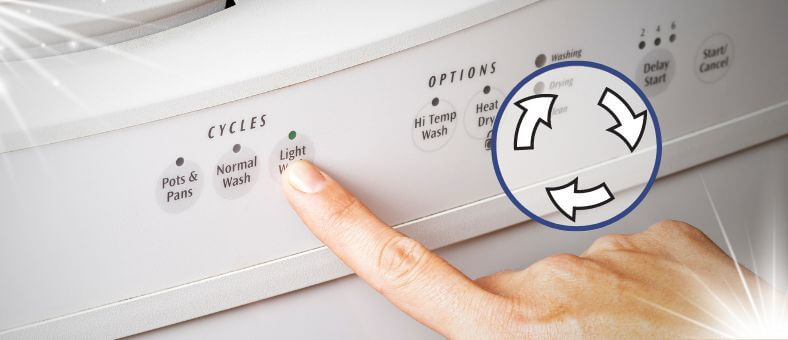
One of the most intriguing aspects of diving into portable dishwashers is their variety of cycle options. Like their built-in counterparts, these compact wonders come equipped with various settings tailored to different dishwashing needs. If you’re keen on a deeper dive into the world of dishwasher cycles in general, take advantage of our comprehensive guide on Dishwasher Cycles and Settings. But for now, let’s demystify these cycle options in portable dishwashers and understand how they enhance the efficiency of such a device.
Standard or Normal Cycle
This is the go-to cycle for everyday dishwashing. It’s designed to handle the usual mix of plates, glasses, and cutlery, ensuring they come out sparkling clean.
Quick or Express Cycle
In a hurry? This cycle is faster than the standard one, perfect for lightly soiled dishes or when you’re short on time.
Heavy or Pots & Pans Cycle
Do you have some filthy pots or caked-on leftovers? This cycle uses more water and higher heat to tackle tough grime.
Eco or Energy-Saving Cycle
For the environmentally conscious, this cycle uses less water and energy. It might take a bit longer, but it’s gentler on the planet and your utility bills.
Rinse Only
Not ready for a full wash but don’t want food to stick? Use this cycle to give your dishes a quick rinse.
Glass or Delicate Cycle
Your delicate glassware and fragile dishes get royal treatment with this gentle cycle, ensuring they’re cleaned without damage.
Understanding the various cycle options helps achieve the desired cleaning results and ensures the dishwasher’s longevity and optimal performance. Choosing the proper cycle for the correct load ensures clean dishes and efficient use of water and electricity. So, next time you load up your portable dishwasher, remember you’ve got many options at your fingertips, all designed to make your dishwashing experience seamless and effective!
Reduced Chemical Release
Due to their efficient cleaning cycles, portable dishwashers often need less detergent. This translates to fewer chemicals entering our water systems, emphasizing the positive environmental impact of portable dishwashers.
Which is Better: a Portable or a Regular Dishwasher?
| Portable Dishwashers | Regular (Built-In) Dishwashers |
|---|---|
| It can handle larger loads, which is great for families or heavy dish use. | Installed permanently under a counter; connected to dedicated plumbing. |
| Compact in size — ideal for small kitchens, apartments, or rental homes. | Larger in size — better suited for full-sized kitchens with more space. |
| Easy to move or store when not in use. | Stationary — becomes a fixed part of your kitchen layout. |
| Typically offer slightly less capacity due to smaller dimensions. | It can handle larger loads, which is excellent for families or heavy dish use. |
| Features may vary by brand; best for basic to moderate dishwashing needs. | Often include advanced features, multiple wash cycles, and higher-end options. |
Is It Safe to Let Your Dishwasher Run While You Sleep?
Running a dishwasher overnight can be tempting, especially for those who prefer waking up to clean dishes. However, it’s always best to be cautious. While portable dishwashers have safety features, there’s always a slight risk of leaks or malfunctions. If you run it overnight, ensure the hoses are securely connected, and there’s no risk of tripping over cords or hoses. Regular maintenance and checks can also reduce potential issues. But for peace of mind, many users prefer to run their dishwasher when they’re awake and around to monitor it. Curious about the optimal time to run your dishwasher? Check out our article on What Is The Best Time Of Day To Run Your Dishwasher? for insights.
How to Set Up a Portable Dishwasher: Step-by-Step Essentials
Setting up a portable dishwasher is a breeze, especially compared to their built-in counterparts. There is no need for complex plumbing or dedicated spaces. Follow these steps:
- Choose the Right Spot: Place your portable dishwasher near the kitchen sink. This will make it easier to connect to the water source and ensure proper drainage.
- Connect to the Faucet: Use the quick-connect adapter with the unit. Attach it securely to your faucet—no special plumbing tools needed.
- Plug It In: Make sure the power cord reaches a nearby outlet. Avoid using extension cords, as they may reduce performance or cause overheating.
- Load Your Dishes: Arrange dishes properly to ensure water reaches all surfaces. For best results, check out our expert guide: How to Load Your Dishwasher Properly
Voila! Your portable dishwasher is ready to tackle those dirty dishes.
Maximizing Efficiency with Design
About 70% of portable dishwasher users report increased satisfaction due to the ergonomic dish rack designs, optimizing space and cleaning efficiency.
Tips to Keep Your Portable Dishwasher Running Smoothly
Regular maintenance is crucial for maintaining the optimal performance of your portable dishwasher. Here are some simple tips to follow:
Regularly Clean the Filter
The filter can get clogged like any dishwasher. Regular cleaning ensures efficient water flow and cleaner dishes. Need help? Follow our detailed guide on 6 Easy Steps to Clean Your Dishwasher Filter for a quick and effective cleaning process.
Inspect the Spray Arm
The spray arm is pivotal in ensuring your dishes come out sparkling clean. Over time, tiny food particles and mineral deposits from hard water can accumulate on the spray arm, potentially blocking the water jets. It’s essential to periodically inspect the spray arm, ensuring it’s free from any obstructions. A simple rinse under running water or a gentle scrub with a soft brush can often dislodge any trapped debris. Ensuring the spray arm can rotate freely without hindrance guarantees that water is evenly distributed, providing a thorough cleaning.
Check the Water Jets
Water jets, strategically positioned within the dishwasher, play a crucial role in dousing your dishes with cleaning power. However, these jets, like the spray arm, can become clogged with food particles or mineral build-up. It’s vital to inspect them regularly to ensure they’re debris-free. Blocked water jets might be the culprit if you notice reduced cleaning efficiency or dishes coming out less clean than they used to. A gentle poke with a toothpick or a soft brush can help clear blockages, ensuring effective cleaning in every cycle.
Use the Right Detergent
For optimal cleaning in portable dishwashers, the right detergent matters. Some models have specific recommendations to ensure dishes sparkle and the machine runs smoothly. Always check your user manual for guidance on detergent use in portable dishwashers, and stick to suggested brands or types for the best results. If you’re on the hunt for the perfect detergent, don’t miss our guide on What is the Best Dishwasher Detergent for Your Washing Needs? to make an informed choice.
Regularly Run a Cleaning Cycle
Run an empty cycle every few weeks with a dishwasher cleaner or white vinegar. This helps in removing any build-up and keeps the interior smelling fresh. If you’ve ever faced unpleasant odors in your dishwasher, our guide on How to Clean a Smelly Dishwasher? offers step-by-step solutions to tackle those pesky smells.
Wrapping Up: Understanding How a Portable Dishwasher Works
Isn’t the world of portable dishwashers absolutely fascinating? From their compact design to their intricate mechanics, these little wonders revolutionize how we approach dish cleaning, especially in space-constrained settings. Now that you’ve delved deep into how a portable dishwasher works, you can truly appreciate the innovation and efficiency packed into every cycle. Let this be your sign if you’ve been on the fence about getting one. Embrace the convenience, save time, and enjoy spotless dishes with minimal effort. Dive into the world of portable dishwashers and elevate your kitchen game today!
At WashDryDazzle, we’re dedicated to providing essential insights that make your daily chores effortless. Dive deeper into our comprehensive Dishwasher Education hub to learn more.
Frequently Asked Questions (FAQs)
How does the capacity of a portable dishwasher compare to a regular built-in dishwasher?
While portable dishwashers are designed for convenience and mobility, they typically have a slightly smaller capacity than standard built-in models. However, many portable units can still handle a significant number of dishes, often accommodating up to 8-10 place settings.
Can I wash larger items like pots and pans in a portable dishwasher?
Yes, you can! While the capacity of portable dishwashers might be slightly smaller, many models come with adjustable racks or special zones designed to fit larger items like pots, pans, and baking sheets. It’s always a good idea to check the user manual for specific guidelines.
How much detergent should I use in my portable dishwasher?
The amount of detergent required can vary based on the hardness of your water and the dishwasher’s capacity. A standard load in soft to medium-hard water typically requires about 15 grams of detergent. If you have hard water, you might need more. Always refer to the detergent label and your dishwasher’s manual for guidance.
How noisy are portable dishwashers compared to built-in models?
Portable dishwashers are generally designed to be quiet, but they might produce slightly more noise than some high-end built-in models due to their mobility and construction. The noise level is measured in decibels (dB). Most portable dishwashers operate within 50-60 dB range, comparable to a normal conversation.
Which are the most reputable portable dishwasher brands?
How does the water filtration system in a portable dishwasher work?
The water filtration system in a portable dishwasher is designed to remove food particles and debris from the wash water. Water circulates during a wash cycle and passes through a filter, trapping any residue. This ensures that dishes are cleaned with fresh, debris-free water throughout the cycle, preventing the redeposition of food particles onto the dishes.

